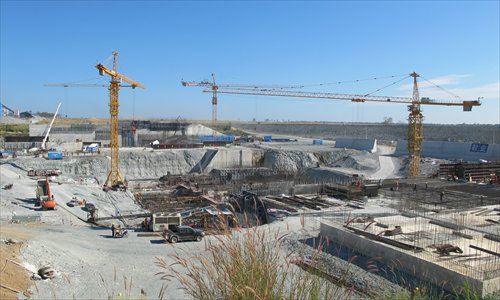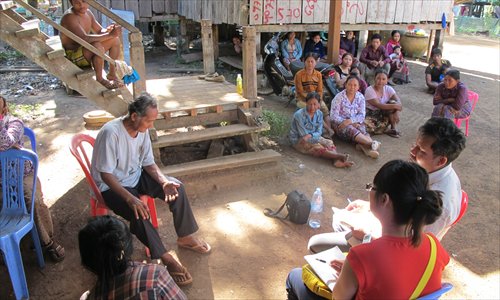Chinese firms learn to cope with resistance to Cambodian projects
Chinese companies invest enormously in the Southeast Asian nation of Cambodia. They serve their own commercial interests, and at the same time help local economies grow. Yet a complex local political environment often makes their work difficult. How should they communicate with local NGOs? How should they ease people's concerns and win over locals?

The Lower Sesan 2 Dam is under construction. Photo: Wang Wenwen/GT
Fed by melting Himalayan snow and monsoon rains, the Mekong River is home to thousands of plant and animal species and millions of people.
The river runs through Cambodia from north to south. It has witnessed the country's suffering during the brutal Khmer Rouge regime followed by the 10-year Vietnamese occupation in the 1980s. Now it sees the country's need for infrastructure and energy, and also controversy around its development path.
Controversial dam project
The Sesan and Srepok rivers in Stung Treng Province, seven hours' drive from the country's capital Phnom Penh, are two major tributaries of the Mekong. Located near the confluence of the two rivers, the Lower Sesan 2 Dam is now 40 percent complete.
If it begins operation when scheduled in late 2017, it will have a capacity of 400 megawatts that will help satisfy demand for electricity in a country that currently imports much of its power.
The dam is the first overseas investment project undertaken by Hydrolancang, a subsidiary of China Huaneng Group, one of the largest power companies in China.
The project was approved by the Cambodian government in 2012. As a build-operate-transfer project, the ownership of the dam will be transferred to Cambodia after 40 years of operation by Hydrolancang.
However, since the start, it has been dogged by controversies around potential environmental damage and its impact on nearby villagers.
"There are still people who don't want to move. More than 5,000 people have to be reallocated. It's not always very clear what the compensation is and it varies depending on the situation and depending on the individuals," Stephanie Jensen-Cormier, China Program Director of International Rivers, an NGO that closely monitors the biodiversity of rivers and the rights of communities that depend on rivers, told the Global Times.
A 2012 study by US and Cambodian researchers estimates that the dam, once constructed, will reduce fish biomass in the Mekong system by more than 9 percent, because it will obstruct the movement of fish and at least 50 species will face extinction.
Tensions and divisions have sprung up within affected communities among those who want to accept compensation provided by Hydrolancang and those who don't.
Srekor 1 and 2 villages are among the affected villages along the Sesan River. In 2014, residents sent an open statement to local authorities, demanding the project halt.
In the village, red signs with "LSS2" (abbreviation for Lower Sesan 2) can be seen on some houses, which means those households have already been measured and the owners have agreed to accept compensation and move to resettlement areas. Those who are not willing to move have hung a striking sign on a tree, reading, "We will die in the village even if the dam is built."
Mekong Sheak, head of Srekor 1 village, told the Global Times that he fears that after the dam is built the area's deep forests will all be gone and there will be no fish in the river.
Feng Lin, deputy director of the general department of Hydro Power Lower Sesan 2 Co Ltd, a joint enterprise of the Royal Group of Cambodia and China's Hydrolancang in charge of the dam project, said the company was aware of villagers' concerns and has designed a fish passage which will allow fish to move freely.
But villagers said they have other concerns.
"We have grandmothers buried in the land. If we leave, they will make us poorer and sick," said 58-year-old Pha Vy. She was one of the community representatives from Srekor 2 village that favored sending the open statement.
"Their ancestors are very important. They are unhappy if they have to move and leave their ancestors behind. They say somebody would die because the ancestors would punish them. They believe that the forests have spirits. That's the way they live their lives," Jensen-Cormier told the Global Times.

Villagers from Srekor 1 and 2 villages talk about their attitudes of the Lower Sesan 2 project. Photo: Wang Wenwen/GT
Chinese presence in Cambodia
Hydrolancang's experience is typical of Chinese companies in Cambodia.
According to a November 2015 report by Cambodia's state news agency AKP, China is the leading investor in Cambodia with a total investment of over $10 billion in the past two decades, which mainly goes toward agriculture, infrastructure, garment manufacturing and mining. Chinese loans and grants to the country reached $2.7 billion in 2012, making it one of Cambodia's largest sources of aid.
Statistics from the Economic and Commercial Counsellor's Office of the Chinese Embassy in Cambodia show that the Cambodian government receives soft loans of $800 million to $1 billion annually, of which 50 percent are from China.
"The Cambodian government must have felt Chinese aid is easier to use. The country has wisdom in looking for aid. It favors China for infrastructure because China is good at it and other countries do not pay as much attention to it as China does," Counsellor Song Xiaoguo told the Global Times.
But the Chinese presence in the country is rarely portrayed favorably in the media. China is portrayed as a gambler hungry for natural resources and a disruptive force that contests for strategic influence and regional domination, as its reach grows longer. The "One Belt, One Road" initiative (B&R initiative) and the new Asian Infrastructure Investment Bank (AIIB) are also seen as proof of China's assertiveness and desire to expand its influence throughout Asia.
"Projects funded by the AIIB and B&R initiative can do much to fill the infrastructure gap in Cambodia but many concerns remain about standards surrounding these projects. These frameworks still leave much space for environmental, social, and political risks so they must be monitored closely from cradle to the grave." Brian Eyler, deputy director of the Southeast Asia program at the Stimson Center in Washington DC, told the Global Times.
Hun Sen, who has been Cambodian prime minister for around 30 years, has never been hesitant to talk about the benefits of Chinese aid and investment to his country's economy. However, Chinese hydropower projects like the Lower Sesan 2 Dam always generate a popular backlash.
Last year, Hun Sen - whose government has been accused of facilitating land-grabs on behalf of private companies by Amnesty International - called a halt to the building of a Chinese mega-dam in southwestern Cambodia due to mounting pressure from local NGOs.
But as most of Cambodia's electricity demand is met by imported electricity from Vietnam and Thailand, Hun Sen once noted that electricity shortage is one of the most serious constraints to Cambodia's effort to attract new investments.
In May 2013, a massive power outage in southern Vietnam left large areas of Phnom Penh without electricity for hours. Another blackout in the capital took place due to a power cut in Vietnam in late November of 2015 when Cambodians were celebrating the annual Water Festival.
"We want to be independent. We want to have energy security. So we want to do a hydro project. We don't have any investors from the West. Why not China?" Phay Siphan, Cambodian secretary of state and spokesman of the government, told the Global Times.
Coping with NGOs
Jensen-Cormier from International Rivers said when her NGO did a report on Chinese companies' hydropower projects overseas and tried to reach Hydrolancang, they didn't get any response.
"It probably didn't think it is important to talk to an NGO," Jensen-Cormier told the Global Times of her first impression about the company, while Feng Lin from the company said they are now learning to communicate more with NGOs.
Since the International Rivers report came out in the summer of 2015, Hydrolancang initiated contact with the NGO in order to increase their score and ranking in the report. They have been in frequent contact since August.
A 2013 figure from the Cooperation Committee for Cambodia shows there are 3,500 registered NGOs in Cambodia of which about half remain active.
Jason Tower is a representative of the East Asia branch of the American Friends Service Committee. The NGO stated work in Koh Kong Province in southwestern Cambodia by carrying out a livelihood project which was localized as a local NGO in 2011 as well as carrying out agricultural training.
He noted that companies from developing countries are often not familiar with how NGOs function and they don't know what the potential consequences are if they talk about human rights and environment with NGOs; at the same time, NGOs sometimes lack information about companies. This makes dialogue difficult.
"Cambodia has a very large number of NGOs, making it difficult for overseas investors to develop strategies to engage them. Meanwhile, the complexity of the local political environment and the developmental context adds to the risks that investors face," Tower said.
Tower and his NGO were invited by a Chinese company to help with community work. Tianjin Union Development Group, a real estate enterprise, is building a "comprehensive economic zone" that will includes a network of roads, an international airport, golf courses and resort on 360 square kilometers in the Botum Sakor National Park, media reported.
This scheme met with obstacles similar to those faced by Hydrolancang. Wang Chao, executive director of Union International Investment Management Group Ltd, a subsidiary of Tianjin Union Development Group, said he keeps receiving requests from local NGOs to halt the project due to accusations of land grabs.
This is a common problem in a country in which Amnesty International claims estimates by local NGOs show that over 400,000 people have been affected by evictions since 2003.
"Opportunities come with risks. Such thoughts are different from the outdated mentality of the West," Wang told the Global Times. "One advantage of us is that we are a private company, so we pay attention to realistic problems and have an internationalized vision. We would like to learn from Western counterpart's experiences and make local residents our umbrella rather than obstacles."
Wang said the corporate social responsibility department of the company is consulting Tower and his NGO about how to help affected villagers participate in the project.
"For example, we are considering offering loans to villagers to start their businesses. We could lend money to five to 10 people. They can buy seeds and feed pigs with that money, and then sell them to the company as a way of payback. The rest of villagers can help monitor if they abuse the money. If the trial is successful, other people can also get loans at the next round," Wang explained.
Anping Public Communication Fund assisted this trip
Newspaper headline: Dam difficult